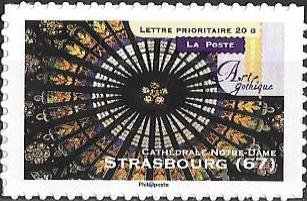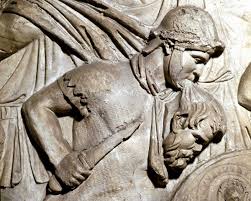Stamp: Notre Dame's Cathefrale - Strasbourg (France 2011)
Notre Dame's Cathefrale - Strasbourg (France 2011)
15 April (France ) within release Gothic Art goes into circulation Stamp Notre Dame's Cathefrale - Strasbourg face value 20 Gram
| Stamp Notre Dame's Cathefrale - Strasbourg in catalogues | |
|---|---|
| Yvert et Tellier: | Yt: FR A558A |
| Michel: | Mi: FR 5087II |
Stamp is horizontal format.
Permanent validity - Priority letter 20g to France Issued from sheet of 50 stamps (white support) - Phosphor stripes broader and less yellowAlso in the issue Gothic Art:
- Stamp - Saint Etienne's Cathedral - Sens face value 20;
- Stamp - Notre Dame's Cathedral - Chartres face value 20;
- Stamp - Notre Dame's Cathedral - Laon face value 20;
- Stamp - Saint Etienne's Cathedral - Metz face value 20;
- Stamp - Saint Pierre Cathedral - Beauvais face value 20;
- Stamp - Saint Etienne's Cathedral - Bourges face value 20;
- Stamp - Notre Dame's Cathefrale - Strasbourg face value 20;
- Stamp - Notre Dame's Cathedrale - Bayeux face value 20;
- Stamp - Notre Dame's Cathedrale - Rouen face value 20;
- Stamp - Sainte Chapelle - Paris face value 20;
- Stamp - Saint Denis's Basilica - Saint Denis face value 20;
- Stamp - Notre Dame's Cathefrale - Strasbourg face value 20;
Stamp Notre Dame's Cathefrale - Strasbourg it reflects the thematic directions:
A church building, often simply called a church, is a building used for Christian religious activities, particularly worship services. The term in its architectural sense is most often used by Christians to refer to their religious buildings, but it is sometimes used (by analogy) for buildings of other religions. In traditional Christian architecture, the church is often arranged in the shape of a Christian cross. When viewed from plan view the longest part of a cross is represented by the aisle and the junction of the cross is located at the altar area. Towers or domes are often added with the intention of directing the eye of the viewer towards the heavens and inspiring church visitors. Modern church buildings have a variety of architectural styles and layouts; many buildings that were designed for other purposes have now been converted for church use; and, similarly, many original church buildings have been put to other uses. The earliest identified Christian church was a house church founded between 233 and 256. During the 11th through 14th centuries, a wave of building of cathedrals and smaller parish churches occurred across Western Europe. A cathedral is a church, usually Roman Catholic, Anglican, Oriental Orthodox or Eastern Orthodox, housing the seat of a bishop.
The Goths (Gothic: 𐌲𐌿𐍄𐌸𐌹𐌿𐌳𐌰, romanized: Gutþiuda; Latin: Gothi, Greek: Γότθοι, translit. Gótthoi) were Germanic people who played a major role in the fall of the Western Roman Empire and the emergence of medieval Europe
The United Nations Educational, Scientific and Cultural Organization (UNESCO; pronounced /juːˈnɛskoʊ/) is a specialized agency of the United Nations (UN) with the aim of promoting world peace and security through international cooperation in education, arts, sciences and culture. It has 194 member states and 12 associate members,as well as partners in the non-governmental, intergovernmental and private sector. Headquartered in Paris, France, UNESCO has 53 regional field offices and 199 national commissions



